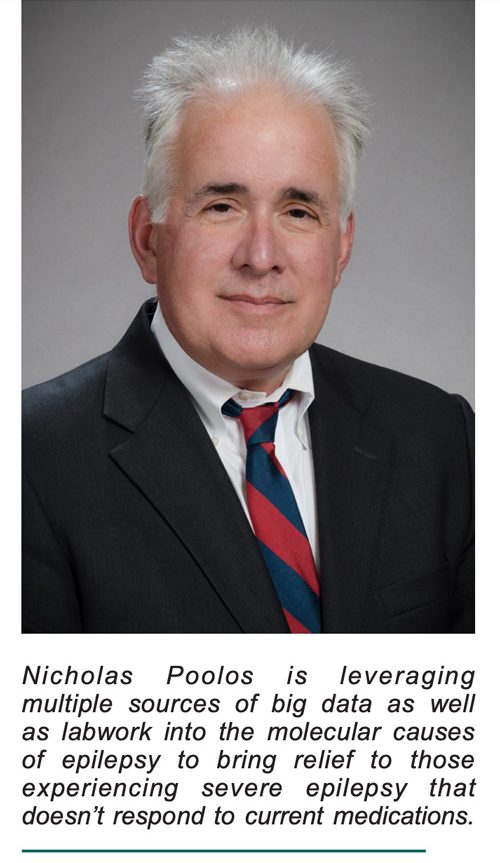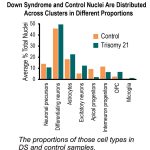Home / Stories /
 by Catherine Arnold
by Catherine Arnold
August 3, 2021
One of the most common brain disorders, epilepsy affects around 1% of the United States population: close to 3 million adults and more than 450,000 children. It was first mentioned in ancient Greek texts and can result from genetic causes or an acquired brain injury, such as a hit to the head or stroke. A third of individuals with epilepsy who experience seizures—those bursts of uncontrolled electrical activity in brain cells that cause sudden uncontrolled movements and loss of consciousness—are not able to be effectively treated by current medications. Very little data exists on what might work for these individuals, who have what are called refractory cases. Gaining additional data will give clinicians more than the current anecdotal evidence for addressing severe epilepsy that isn’t easily treated by standard medications.
In a recently funded NIH grant, Nicholas Poolos, MD, PhD, professor and interim chair of the Department of Neurology and his colleagues are mining big data to discover which antiepileptic drug (AED) regimens are most effective. Poolos is also the director of the University of Washington Regional Epilepsy Center and a research affiliate of the Center on Human Development and Disability. “We started this research,” Poolos notes, “to answer the question: Is there a combination that works better than anything else, or any single drug?” To do so, they needed large amounts of data to conduct a retrospective analysis, crunching data from numerous patient sources.
Early Research
In 2011, Poolos and colleagues began to analyze records they received permission to review from two centers at Washington State institutions providing services to individuals with intellectual and developmental disabilities. Approximately 40% of individuals residing in these settings have refractory epilepsy. Fortunately, staff had kept spreadsheet records since the 1980s of seizure numbers per individual per month and medications used. “It was an unbelievable treasure trove of data,” says Poolos: “quantitative and allowing us to ask questions about which medication combinations worked.” After crunching the data, Poolos and colleagues realized that among 32 medications most often used at the two centers, only one combination made a significant statistical difference in controlling seizures: lamotrigine and valproate.
With that drug combination, patients generally experienced a 50% seizure decrease. “Even if it doesn’t make you seizure-free, cutting in half your chances of seizures and injury is worthwhile,” says Poolos. “That made us think, ‘We have a piece of guidance we can give clinicians: When all else fails, try this.’” Poolos and his research colleagues published their findings, including evidence for the value of low dosage use. But there was a hitch: Information was needed from a much broader range of patients more representative of those without a severe developmental disability
Big Data Analyses
Poolos’ current NIH project is designed to conduct analyses from data obtained from typical patients in the community with refractory epilepsy. He and his team are achieving this in two ways. First, they gained access to anonymous records from two online and mobile apps (My Epilepsy Diary and Seizure Tracker) that individuals with epilepsy use to track their seizures and treatments by their doctors. There are pluses and minuses to crunching data from such online or mobile records, Poolos says. For one thing, individuals on their own may use an app for a month, then trail off. However, “tens of thousands” of people use the app: “We’re hopeful the big numbers will even out our results,” says Poolos.
Based on a preliminary analysis of the data from the two apps, Poolos and his group observed that the same combination of lamotrigine and valproate showed a 40% decrease in seizure frequency for community-based patients. “This project appears to be validating our previous work, but we still have work to do in the total analysis,” says Poolos.
In the project’s second segment, the researchers plan to use tools to search electronic health records from the last three decades at UW Medicine clinics. They’ll search for such lines as “has become seizure free” and “since we did X, seizures have stopped” to identify patients whose medical management stopped seizures. Pulling tens of thousands of records to validate the information, they’ll examine associated medications.
Translational Directions
As a scientific researcher and clinical neurologist at UW Regional Epilepsy Center, Poolos works with patients referred from surrounding states and the Puget Sound when presented with difficult epilepsy cases. “Seeing these patients day in and day out, I want to do something for them besides just flying by the seat of my pants.” In the lab, he and colleagues work to understand molecular changes that occur in the brain after a head injury that can lead to epilepsy. “God forbid a brick falls on your head and you develop epilepsy—trauma is a common way epilepsy happens, but it doesn’t occur instantaneously. One challenge is to understand what makes the brain tissue electrically hyperexcitable and begin to cause seizures.”
Conclusion
Combining lamotrigine with valproate has become standard treatment for refractory patients in UW Regional Epilepsy Center clinics, says Poolos. “My colleagues have heard me talk about it endlessly—it’s very satisfying to see your colleagues, who are smart and maybe even skeptical people, come around to your way of thinking on things.” With further research, Poolos hopes to inform others in the treatment community about which drug combinations can help even the most difficult cases of epilepsy. He also hopes that this work will stimulate advocacy, gain funding, and raise awareness in this critical area of research and clinical practice.


